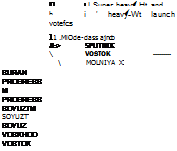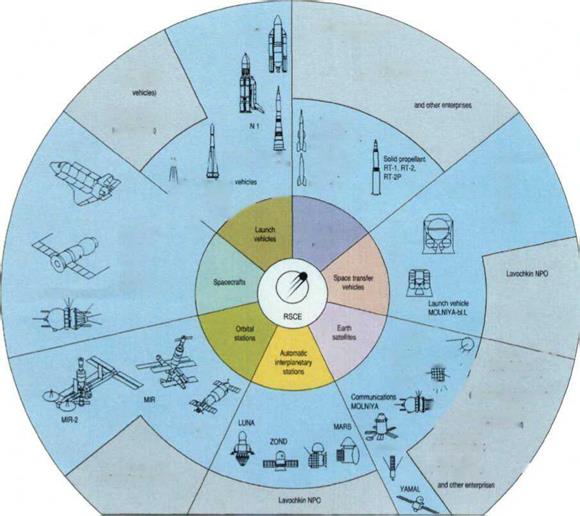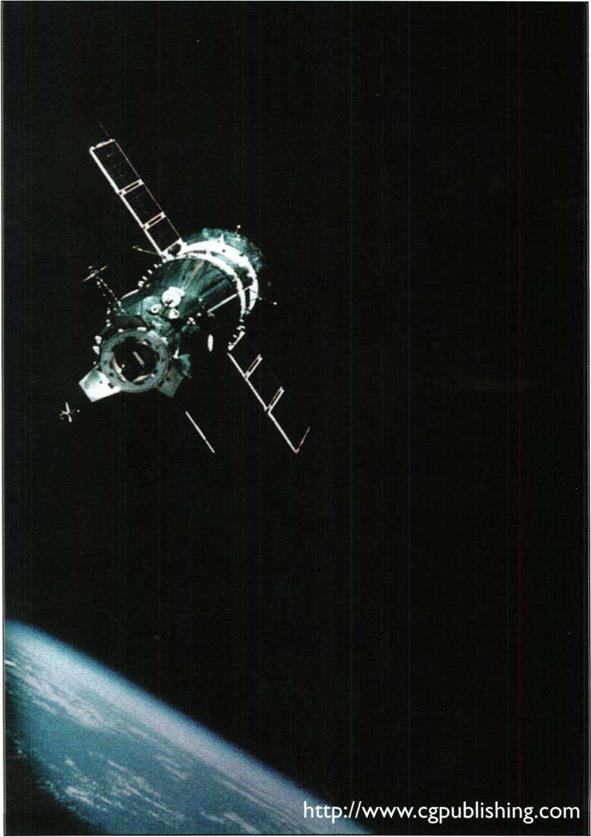Dates of Milestones in Rocket-Space. Technology Creation at. 0KB-1 – TsKBEM – NPO Energia
May 13, 1946
The decision of the Government to form a number of Research Institutes (Nil’s), Design Bureaus (KB’s).test organizations, and plants to develop, manufacture and test long-range ballistic rockets (LRBR). S. P. Korolev was appointed as the chief designer of liquid propellant LRBR.
October 18,1947
The first launch of an LRBR in the Soviet Union – based on the German A4 (V-2) rocket.
September 17, 1948
The first launch of a native LRBR R-l. The rocket almost reached the specified range, but experienced a large deviation from the planned flight path because of abnormal operation of the control system.
October 10, 1948
The first successful launch of a native LRBR R-l.
April 21,1949
The first launch (of six) of a geophysical rocket, the R-1 A. Experiments with rocket head separation were performed on this rocket. The rocket lifted two instrumentation containers to an altitude of 100 km, which then landed by parachutes.
September 21,1949
Launch of the R-2E rocket, an experimental check of the new R-2 rocket system’s serviceability.
1950
The R-1 rocket complex is put into service. 1949-1951
The R-2 rocket, with a separable head, is created, then the R-2 complex is put into service.
1951-1956
Geophysical rockets R-1 B, R-1 E, R-1D and others, and the R-2A are created and launched. Upper atmospheric and space research is continued.
March 15,1953
The first R-5 strategic rocket is launched. A modification of the R-5 (R-5M, first launched on January 21, 1955) was fitted with a special explosive charge. Geophysical rockets R-5A (launches in 1958-1961), R-5V (launches in 1964-1975, among them launches within the Vertical program), and others are created based on R-5 rockets.
April 18, 1953
The first launch of an R-l I tactical missile. September 16, 1955
The first submarine launch of an R-l IFM missile.
May 15, 1957
The first launch of an R-7 intercontinental ballistic two-stage missile.
August21,1957
The successful launch of an R-7 intercontinental ballistic two-stage missile.
October 4, 1957
The launch of the first artificial Earth-orbiting satellite, a mass of 83.6 kg. It remained in orbit for more than 92 days. On January 4, 1958 the satellite entered the dense upper atmosphere and burned up.
Novembers, 1957
The launch of the second artificial satellite, of 508 kg mass, with dog Laika on board.
May 15, 1958
The launch of the third artificial satellite, a mass of 1,327 kg, by an R-7-type rocket with improved performance characteristics.
January2,1959
The launch of the first interplanetary station Luna-1 (Mechta) by an R-7 three-stage rocket, with a rocket unit E used as the third stage.
September 12, 1959
The launch of the Luna-2 station which delivered a USSR pennant to the Moon’s surface on September 14, 1959.
October 14,1959
The launch of the Luna-3 station, which photographed the back side of the Moon.
May 15, 1960
The launch of an unmanned Vostok-type spacecraft (I KP).
August 19, 1960
TheVostok spacecraft (with dogs Belka and Strelka on board) is put into orbit. The animals were the first to be recovered from satellite orbit.
February 12,1961
The Four-stage rocket (R-7 + rocket units I and L) puts into orbit an unmanned interplanetary station (UlS)Venera-l (IVANo2).
April 12,1961
The first manned spacecraft – Vostok – (3KA) with Yuri Alexeyevich Gagarin on board goes into orbit.
April26, 1962
The launch of a Zenit satellite to photograph the Earth’s surface.
August 11-12, 1962
The first group space flight, comprised of the Vostok-3 and Vostok-4 spacecraft.
November I, 1962
The unmanned interplanetary station Mars-1 (2MV-4 No 4) is put into orbit by a four-stage rocket.
January 30, 1964
The Electron-1 and Electron-2 satellites are launched by a single rocket to investigate the Earth’s radiation belts (Van Allen belts).
October 12,1964
The Voskhod multi-man spacecraft is put into orbit (3KV) – the first multi-man space flight.
March 18, 1965
The Voskhod-2 (3KD) spacecraft goes into orbit. A. A.Leonov makes the first ever egress into space.
1961-1968
The R-9, RT-1 and RT-2 rocket complexes are created. R-9 and RT-2 complexes are added to the national armory.
April 23, 1965
The launch of the Molniya-l active retransmitter to provide an experimental long-distance radio communication line.
November16,1965
The launch of the Venera-3 unmanned interplanetary station which delivered a pennant to the surface of Venus on March I, 1966.
January 31, 1966
The Luna-9 unmanned interplanetary station performs a soft landing on the Moon and transmits TV images of the Moon’s surface to Earth.
March 10, 1967
The first (Zond) spacecraft launch of the LI (7K-LI) program.
April23,1967
The launch of a new spacecraft – Soyuz-1 – with V. M. Komarov on board.
October 30, 1967
Automatic docking of Soyuz-type spacecraft (Cosmos-186 – Cosmos-188).
January 15, 1969
Docking of the Soyuz-4 and Soyuz-5 manned spacecraft. Cosmonauts transfer from one spacecraft to the other through outer space. Creation of an experimental station of 12,924 kg mass.
1961-1974
Work carried out on the Moon program to create a modular multi-purpose launch vehicle, NI, and a lunar complex, L3. On February 21, 1969, complex NI-L3 flight tests began. The program was canceled because of breakdown of the schedule for the lunar complex creation, and after four (out of four) launch failures.
April 19,1971
The launch of the Salyut orbital station, which stayed in orbit until October I I, 1971.
June 30, 1971
The Soyuz-1 I spacecraft goes into orbit, and then docks with the Salyut orbital station. This marks the beginning of manned flight mode operation for the Salyut station (which lasted 22 days).
December 26, 1974
The launch of the Salyut-4 station. lt remained in orbit until February 3, 1977.Two crews operated on board the station.
July 15, 1975
The Soyuz-19 spacecraft is launched, which then docks to the U. S.Apollo spacecraft on July 17, 1975. The first experimental flight of a space complex comprised of spacecraft from two countries (the Apollo-Soyuz program).
1976
Beginning of work on the Energia versatile space transportation system and the Buran orbiter.
September 29, 1977
The Salyut-6 station – a station of the second generation – with two docking units is put into orbit. It remained in orbit until July 29, 1982. 16 crews operated on board the station.
December 10, 1977
The Soyuz-26 spacecraft goes into orbit, then docks with the Salyut-6 orbital station. This begins the Salyut-6 manned operation mode.
January 20, 1978
The first Progress unmanned cargo transport spacecraft flight. The first delivery of cargoes to the station by the transport spacecraft.
March 2, 1978
The Soyuz-28 spacecraft, with the first international crew on board, goes into orbit and docks with the Salyut-6 orbital station.
December 16, 1979
The Soyuz T first unmanned flight. It docks with the Salyut-6 orbital station and the Salyut-6 / Soyuz T complex flight continues for more than 100 days.
June S, 1980
The Soyuz T-2 manned spacecraft is launched and docks with the Salyut-6 orbital station.
April 19,1982
The Salyut-7 station – a Salyut-6 station back-up – is put into orbit. It remained in orbit until February 7, 1991.Ten crews operated on board the station.
February 20, 1986
The core module of the Mir permanent manned complex is put into orbit. Manned operation mode began on March 15, 1986. Three special-purpose modules (Kvant astrophysics module, launched on March 31, 1987; Kvant-2 add-on module, launched on December 6, 1989; and Kristall technological module, launched on May 31, 1990), as well as a Progress M-type cargo spacecraft and Soyuz TM-type transport spacecraft (with the main crew and a visiting one) are docked to the core module.
March 13, 1986
The Soyuz T-15 spacecraft is launched and docks with the Mir complex on March 15, beginning of the complex manned operation mode. Soyuz T-15 performs an orbital transfer to the Salyut-7 station and back to Mir (May 5 – June 26) and delivers 400 kg of cargo from Salyut-7 to the Mir complex for further use.
May 21, 1986
Docking of the first Soyuz TM spacecraft (Soyuz TM – I), in unmanned mode, to the Mir complex.
February 6, 1987
The launch of the Soyuz TM-2 manned spacecraft which docks with the Mir orbital complex.
May 15,1987
The launch of an Energia launch vehicle with the Skif-DM spacecraft on external suspension.
November 15,1988
An Energia launch vehicle launch with the Buran orbiter attached in an unmanned mode.
August 23, 1989
The launch of a Progress M unmanned cargo transport spacecraft.
1990
Beginning of work on the Energia-M launch vehicle. September 27, 1990
The launch of a Progress M-5 cargo spacecraft with a recovery ballistic capsule on board which delivers the onboard results to the ground. The landing was performed on November 28, 1990.
December 2, 1990
Soyuz TM-1 I – Mir Expedition with an international crew including T. Akiyama (a Japanese journalist), the first commercial passenger to Mir. Akiyama made daily television broadcasts.
1992
The beginning of extensive international activities in joint space exploration programs.
March 17, 1992
Soyuz TM-14 – Joint flight with Germany.
1993
Activities in the Mir complex program continue. The 14th expedition began to operate on board the Mir complex from July I.
February 3-11,1994
STS-60 was the first flight of a cosmonaut aboard the US Shuttle. Sergei K. Krikalev as a mission specialist conducted joint science programs.
November 12-20, 1994
STS-74 was the first shuttle assembly flight to Mir, it carried a Russian-built docking module with two attached solar arrays.
May 1995
The Spektr ("Spectrum") module joined Mir in May 1995.The module was designed for scientific research, specifically Earth observation. The final module was the Spektr Remote Sensing Payload. It had instruments to study particles in low Earth orbit. This module was damaged in the collision with a supply ship and was closed up pending final repairs that were never finally completed.
June 27 – July 7, 1995
STS-71 Atlantis performs the first US Shuttle docking with Mir.
1995
The docking module was added to Mir during the second US Shuttle / Mir docking mission, STS-74, in late 1995.
March 22-31, 1996
STS-76 began the continuous U. S. stay on Mir. A single Spacehab module was aboard, demonstrating logistics capabilities.
April 1996
The Priroda ("Nature") module was launched in April 1996, completing the assembly of the Mir complex. This module carried Earth observing equipment as well as experiments.
August 17, 1996
This launch was the first of the Soyuz-U boosters with a crew aboard.
February 1997
During February, a fire occurred aboard Mir, offering new challenges and new information. The first spacewalk by a U. S. astronaut outside Mir wearing a Russian spacesuit was made.
June 25, 1997
The Progress M-34 spacecraft crashes into Spektr. The collision damaged one of the solar panels and also punctured the hull, depressurizing the module.
September 25 – October 6, 1997
Astronaut Scott Parazynski and Cosmonaut Vladimir Titov conducted a joint spacewalk.
November 20, 1998
The Zarya ISS module is launched by a Proton rocket for rendezvous with the US Unity module. The hatch between Unity and Zarya is opened for the first time on Dec 10, 1998.
February20,1999
SoyuzTM-29 docked with Mir on February 22. After accepting a double-length assignment, Russian cosmonaut Viktor Afanasyev set a new cumulative time in space record, but then, for the first time since September 1989, there were no humans in space.
July 12,2000
The Zvezda ISS module is launched by Proton rocket and docks with the ISS Zarya module on Jul 26. The ISS now consists of three modules: Zvezda, Zarya and Unity.
October 31, 2000
Soyuz TM-31 spacecraft launched by Soyuz-U rocket carrying the crew of the first ISS Expedition and docks with the ISS Zvezda module on November 2, 2000.
February 20,2001
The core module of the Mir space station celebrates its fifteenth anniversary in orbit.
March 18,2001
"Rock", the first of a pair of direct broadcast digital radio satellites is launched from the Sea Launch platform in the Pacific Ocean by a Zenit rocket into geosynchronous transfer orbit.
March 23,2001
The Mir space station is deorbited successfully. Fragments of the world’s most successful space station hit in a remote area of the Pacific following fifteen years of unprecedented orbital research.
To receive more information about conclusion of agreement on services with use of space/rocket technology, address:
KSCE
141070 Kaliningrad Moscow region, Lenin street, 4a Telephone: (095) 513-72-48. Fax: (095) 187-98-77
|
|
|
|
|
|
|
|
|
|
|
|
|
|
|
|
|
|
 |
|
|
|
|
|
|
|
 |
|
|
|
|
|
|
|

|
|











